Influence of the Coupling South Atlantic Convergence Zone-El Niño-Southern Oscillation (SACZ-ENSO) on the Projected Precipitation Changes over the Central Andes
Abstract
1. Introduction
2. Materials and Methods
2.1. Data
2.2. CMIP5 GCMs
2.3. RegCM4 Simulation
2.4. Methods
3. Results
3.1. Performance of the CMIP5 Models in Simulating the SACZ
3.2. Performance of the RegCM4 Model
3.3. Projected Changes in Precipitation and Circulation over the Equatorial Pacific Ocean and South America
3.4. Projected Trends of Rainfall in the Central Andes
4. Discussion and Conclusions
Supplementary Materials
Author Contributions
Funding
Data Availability Statement
Acknowledgments
Conflicts of Interest
References
- Zhou, J.; Lau, K.M. Does a monsoon climate exist over South America? J. Clim. 1998, 11, 1020–1041. [Google Scholar] [CrossRef]
- Rai, A.; Cavalcanti, I.F.A. The life cycle of the South American Monsoon System. J. Clim. 2008, 21, 6227–6246. [Google Scholar] [CrossRef]
- Marengo, J.A.; Soares, W.R.; Saulo, C.; Nicolini, M. Climatology of the low-level jet east of the Andes as derived from the NCEPNCAR reanalysis. Characteristics and temporal variability. J. Clim. 2004, 17, 2261–2280. [Google Scholar] [CrossRef]
- Chen, T.-S.; Weng, S.-P.; Schubert, S. Maintenance of austral summertime upper-tropospheric circulation over tropical South America: The Bolivian high–Nordeste low system. J. Atmos. Sci. 1999, 56, 2081–2100. [Google Scholar] [CrossRef]
- Liebmann, B.; Kiladis, G.N.; Marengo, J.A.; Ambrizzi, T.; Glick, J.D. Submonthly convective variability over South America and the South Atlantic convergence zone. J. Clim. 1999, 12, 1977–1991. [Google Scholar] [CrossRef]
- Kodama, Y.M. Large-scale common features of subtropical precipitation zones (the Baiu frontal zone, the SPCZ, and the SACZ). Part I: Characteristics of subtropical frontal zones. J. Meteor. Soc. Jpn. 1992, 70, 813–835. [Google Scholar] [CrossRef]
- Barreiro, M.; Chang, P.; Saravanan, R. Variability of the South Atlantic Convergence Zone simulated by an atmospheric general circulation model. J. Clim. 2002, 15, 745–763. [Google Scholar] [CrossRef]
- Silva Dias, P.L.; Schubert, W.H.; De Maria, M. Large-scale response of the tropical atmosphere to transient convection. J. Clim. 1893, 40, 2689–2707. [Google Scholar] [CrossRef]
- Sulca, J.; Vuille, M.; Timm, O.E.; Dong, B.; Zubieta, R. Empirical-statistical downscaling of austral summer precipitation over South America during extreme El Niño episodes, with a focus on the central Andes of Peru and the equatorial Amazon basin. J. Appl. Meteorol. Climatol. 2021, 60, 65–85. [Google Scholar] [CrossRef]
- Neukom, R.; Rohrer, M.; Calanca, P.; Salzmann, N.; Huggel, C.; Acuña, D.; Christie, D.A.; Morales, M.S. Facing unprecedented drying of the Central Andes? Precipitation variability over the period AD 1000–2100. Environ. Res. Lett. 2015, 10, 084017. [Google Scholar] [CrossRef]
- Minvielle, M.; Garreaud, R.D. Projecting rainfall changes over the South American Altiplano. J. Clim. 2011, 24, 4577–4583. [Google Scholar] [CrossRef]
- Vuille, M.; Keimig, F. Interannual variability of summertime convective cloudiness and precipitation in the central Andes derived from ISCCP-B3 data. J. Clim. 2004, 17, 3334–3348. [Google Scholar] [CrossRef]
- Garreaud, R.D.; Vuille, M.; Compagnucci, R.H.; Marengo, J. Present-day South American Clim. Palaeogeogr. Palaeoclimatol. Palaeoecol. 2009, 281, 180–195. [Google Scholar] [CrossRef]
- Segura, H.; Junquas, C.; Espinoza, J.-C.; Vuille, M.; Jauregui, Y.R.; Rabatel, A.; Condom, T.; Lebel, T. New insights into the rainfall variability in the tropical Andes on seasonal and interannual time scales. Clim. Dyn. 2019, 53, 405–426. [Google Scholar] [CrossRef]
- Sulca, J.; Takahashi, K.; Espinoza, J.-C.; Vuille, M.; Lavado-Casimiro, W. Impacts of different ENSO flavors and tropical Pacific convection variability (ITCZ, SPCZ) on austral summer rainfall in South America, with a focus on Peru. Int. J. Climatol. 2018, 38, 420–435. [Google Scholar] [CrossRef]
- Lavado-Casimiro, W.; Espinoza, J.-C. Impact of El Niño and La Niña on rainfall in Peru. Rev. Bras. Meteorol. 2014, 29, 171–182. [Google Scholar] [CrossRef]
- Bjerknes, J. Atmospheric teleconnections from the equatorial Pacific. Mon. Wea. Rev. 1969, 97, 163–172. [Google Scholar] [CrossRef]
- Takahashi, K.; Dewitte, B. Strong and moderate nonlinear El Niño regimes. Clim. Dyn. 2016, 46, 1627–1645. [Google Scholar] [CrossRef]
- Dewitte, B.; Takahashi, K. Diversity of moderate El Niño events evolution: Role of air-sea interactions in the eastern tropical Pacific. Clim. Dyn. 2019, 52, 7455–7476. [Google Scholar] [CrossRef]
- Jauregui, Y.R.; Takahashi, K. Simple physical-empirical model of the precipitation distribution in the tropical oceans and the effects of climate change. Clim. Dyn. 2018, 50, 2217–2237. [Google Scholar] [CrossRef]
- Buytaert, W.; Celleri, R.; Timbe, L. Predicting climate change impacts on water resources in the tropical Andes: Effects of GCM uncertainty. Geophys. Res. Lett. 2009, 36. [Google Scholar] [CrossRef]
- Zubieta, R.; Saavedra, M.; Espinoza, J.-C.; Ronchail, J.; Sulca, J.; Drapeau, G.; Martin-Vide, J. Assessing precipitation concentration in the Amazon basin from different satellite-based datasets. Int. J. Climatol. 2019. [Google Scholar] [CrossRef]
- Buytaert, W.; Vuille, M.; Dewulf, A.; Urrutia, R.; Karmalkar, A.; Celleri, R. Uncertainties in climate change projections and regional downscaling in the tropical Andes: Implications for water resources management. Hydrol. Earth Syst. Sci. 2010, 14, 1247–1258. [Google Scholar] [CrossRef]
- Mishra, Y.; Nakamura, T.; Babel, M.S.; Ninsawat, S.; Ochi, S. Impact of climate change on water resources of the Bheri River basin. Nepal. Water. 2018, 10, 220. [Google Scholar] [CrossRef]
- Meehl, G.A.; Bony, S. Introduction to CMIP5. Clivar Exch. 2011, 56, 4–5. [Google Scholar]
- Tian, B.; Dong, X. The double-ITCZ bias in CMIP3, CMIP5, and CMIP6 models based on annual mean precipitation. Geophys. Res. Lett. 2020, 47. [Google Scholar] [CrossRef]
- Vasconcellos, F.C.; Deng, Y.; Zhang, H.; Martin, G. Austral summer precipitation biases over tropical South America in five CMIP5 earth system models. Int. J. Climatol. 2020. [Google Scholar] [CrossRef]
- Zazulie, N.; Rusticucci, M.; Raga, G.B. Regional climate of the subtropical central Andes using high-resolution CMIP5 models-part I: Past performance (1980–2005). Clim. Dyn. 2017, 49, 3917–3957. [Google Scholar] [CrossRef]
- Sulca, J. Evidence of nonlinear Walker circulation feedbacks on extreme El Niño Pacific diversity: Observations and CMIP5 models. Int. J. Climatol. 2021, 41, 2934–2961. [Google Scholar] [CrossRef]
- Karamperidou, C.; Jin, F.F.; Conroy, J.L. The importance of ENSO nonlinearities in tropical Pacific response to external forcing. Clim. Dyn. 2017, 49, 2695–2704. [Google Scholar] [CrossRef]
- IPCC. Climate Change 2013: The Physical Science Basis. Contribution of Working Group I to the Fifth Assessment Report of the Intergovernmental Panel on Climate Change; Stocker, T.F.D., Qin, G.-K., Plattner, M., Tignor, S.K., Allen, J., Boschung, A., Nauels, Y., Xia, V.B., Midgley, P.M., Eds.; Cambridge University Press: Cambridge, UK, 2013; p. 1535. [Google Scholar]
- Seiler, C.; Hutjes, R.W.A.; Kabat, R. Likely ranges of climate change in Bolivia. J. Appl. Meteorol. Climatol. 2013, 52, 1303–1317. [Google Scholar] [CrossRef]
- Yin, L.; Fu, R.; Shevliakova, E.; Dickinson, R.E. How well can CMIP5 simulate precipitation and its controlling processes over tropical South America? Clim. Dyn. 2013, 41, 3127–3143. [Google Scholar] [CrossRef]
- Palomino-Lemus, R.; Córdoba-Machado, S.; Gámiz-Fortis, S.R.; Castro-Díez, Y.; Esteban-Parra, M.J. Summer precipitation projections over northwestern South America from CMIP5 models. Glob. Planet. Chang. 2015, 131, 11–23. [Google Scholar] [CrossRef]
- Abadi, A.M.; Oglesby, R.; Rowe, C.; Mawalagedara, R. Evaluation of GCMs historical simulation of monthly and seasonal climatology over Bolivia. Clim. Dyn. 2018, 51, 733–754. [Google Scholar] [CrossRef]
- Sulca, J.; Vuille, M.; Silva, Y.; Takahashi, K. Teleconnections between the central Peruvian Andes and Northeast Brazil during extreme rainfall events in austral summer. J. Hydrometeorol. 2016, 17, 499–515. [Google Scholar] [CrossRef]
- Moss, R.H. Coauthor. The next generation of scenarios for climate change research and assessment. Nature 2010, 823, 747–756. [Google Scholar] [CrossRef]
- Schwalm, C.R.; Glendon, S.; Duffy, P.B. RCP8.5 tracks cumulative C02 emmisions. Proc. Natl. Acad. Sci. USA 2020, 826, 19656–19657. [Google Scholar] [CrossRef] [PubMed]
- Riahi, K.; Rao, S.; Krey, V.; Cho Ch Chirkov, V.; Fischer, G.; Kidermann, G.; Nakicenovic, N.; Rafaj, P. RCP 846 8.5-A scenario of comparatively high greenhouse gas emissions. Clim. Chang. 2011, 109, 33–57. [Google Scholar] [CrossRef]
- Wongchuig, S.C.; Mello, C.R.; Chou, S.C. Projections of the impacts of climate change on the water deficit and on the precipitation erosive indexes in Mantaro River Basin, Peru. J. Mt. Sci. 2018, 15, 264–279. [Google Scholar] [CrossRef]
- Urrutia, R.; Vuille, M. Climate Change Projections for the tropical Andes using a regional climate model: Temperature and precipitation simulations for the end of the 21st century. J. Geophys. Res. 2009, 114, D02108. [Google Scholar] [CrossRef]
- Benestad, R.E.; Hanssen-Bauer, I.; Chen, D. Empirical–Statistical Downscaling; World Scientific: Singapore, 2008; p. 228. [Google Scholar]
- Maraun, D. Bias correcting climate change simulations—A critical review. Curr. Clim. Chang. Rep. 2016, 2, 211–220. [Google Scholar] [CrossRef]
- Segura, H.; Espinoza, J.-C.; Junquas, C.; Lebel, T.; Vuille, M.; Garreaud, R. Recent changes in the precipitation-driving processes over the southern tropical Andes/western Amazon. Clim. Dyn. 2020, 54, 2613–2631. [Google Scholar] [CrossRef]
- Gonzáles-Zeas, D.; Erazo, B.; Lloret, P.; De Bièvre, B.; Steinschneider, S.; Dangles, O. Linking global climate change to local water availability: Limitations and prospects for a tropical mountain watershed. Sci. Total Environ. 2019, 650, 2577–2586. [Google Scholar] [CrossRef]
- Zubieta, R.; Molina-Carpio, J.; Laqui, W.; Sulca, J.; Ilbay, M. Comparative Analysis of Climate Change Impacts on Meteorological, Hydrological, and Agricultural Droughts in the Lake Titicaca Basin. Water 2021, 13, 175. [Google Scholar] [CrossRef]
- Reboita, M.S.; da Rocha, R.P.; Dias, C.G.; Ynoue, R.Y. Climate projections for South America: RegCM3 driven by HadCM3 and ECHAM5. Adv. Meteorol. 2014. [Google Scholar] [CrossRef]
- Llopart, M.; Reboita, M.S.; da Rocha, R.P. Assessment of multimodel climate projections of water resources over South America CORDEX domain. Clim. Dyn. 2020, 54, 99–116. [Google Scholar] [CrossRef]
- Guzman, D. Clima Presente E Tendências Climáticas Usando O Modelo Regional RegCM4 Sobre Regiões De Topografia Complexa Dos ANDES. Master’s Thesis, University of São Paulo, São Paulo, Brazil, 2019; p. 102. Available online: https://www.iag.usp.br/pos/sites/default/files/d_decker_zabalaga_corrigida.pdf (accessed on 20 January 2021).
- Adler, R.F.; Huffman, G.J.; Chang, A.; Ferraro, R.; Xie, P.; Janowiak, J.; Rudolf, B.; Schneider, U.; Scott, C.; Bolvin, D.; et al. The version-2 Global Precipitation Climatology Project (GPCP) monthly precipitation analysis (1979–present). J. Hydrometeorol. 2003, 4, 1147–1167. [Google Scholar] [CrossRef]
- Kalnay, E.; Kanamitsu, M.; Kistler, R.; Collins, W.; Deaven, D.; Gandin, L.; Iredell, M.; Saha, S.; White, G.; Woollen, J.; et al. The NCEP/NCAR 40-Year Reanalysis Project. Bull. Amer. Meteor. Soc. 1996, 77, 437–472. [Google Scholar] [CrossRef]
- Liebmann, B.; Smith, C.A. Description of a complete (interpolated) outgoing longwave radiation dataset. Bull. Am. Meteorol. Soc. 1996, 77, 1275–1277. [Google Scholar]
- MDE Global STRM. Available online: https://dds.cr.usgs.gov/srtm/version2_1/SRTM30/srtm30_documentation.pdf (accessed on 1 January 2019).
- Funk, C.; Peterson, P.; Landsfeld, M.; Pedreros, D.; Verdin, J.; Shukla, S.; Husak, G.; Rowland, J.; Harrison, L.; Hoell, A.; et al. The climate hazards infrared precipitation with stations—A new environmental record for monitoring extremes. Sci. Data 2015, 150066. [Google Scholar] [CrossRef]
- K, T.; Stouffer, R.M. An overview of CMIP5 and the experiment design. Bull. Am. Meteor. Soc. 2012, 93, 485–498. [Google Scholar] [CrossRef]
- Giorgi, F.; Coppola, E.; Solmon, F.; Mariotti, L.; Sylla, M.B.; Bi, X.; Elguindi, N.; Diro, G.T.; Nair, V.; Giuliani, G.; et al. RegCM4: Model description and preliminary tests over multiple CORDEX domains. Clim. Res. 2012, 62, 7–29. [Google Scholar] [CrossRef]
- da Rocha, R.P.; Reboita, M.S.; Dutra, L.M.M.; Llopart, M.P.; Coppola, E. Interannual variability associated with ENSO: Present and future climate projections of RegCM4 for South America-CORDEX domain. Clim. Chang. 2014, 125, 95–109. [Google Scholar] [CrossRef]
- Giorgi, F. Introduction to the special issue: The phase I CORDEX RegCM4 hyper-matrix (CREMA) experiment. Clim. Chang. 2014, 125, 1–5. [Google Scholar] [CrossRef]
- Martin, G.M.; Collins, W.J.; Culverwell, I.D.; Halloran, P.R.; Hardiman, S.C.; Hinton, T.J.; Jones, C.D.; McDonald, R.E.; McLaren, A.J. The HadGEM2 family of met office unified model climate configurations. Geosci. Model. Dev. Discuss. 2011, 4, 765–841. [Google Scholar] [CrossRef]
- Giorgetta, M.; Jungclaus, J.; Reick, C.; Legutke, S.; Brovkin, V.; Crueger, T.; Esch, M.; Fieg, K.; Glushak, K.; Gayler, V.; et al. CMIP5 simulations of the Max Planck Institute for Meteorology (MPI-M) based on the MPI-ESM-LR model: The rcp85 experiment, served by ESGF. World Data Cent. Clim. 2012. [CrossRef]
- Dunne, J.P.; John, J.G.; Adcroft, A.J.; Griffies, S.M.; Hallberg, R.W.; Shevliakova, E.; Stouffer, R.J.; Cooke, W.; Dunne, K.A.; Harrison, M.J.; et al. GFDL’s ESM2 global coupled climate-carbon Earth system models. Part I: Physical formulation and baseline simulation characteristics. J. Clim 2012, 25, 6646–6665. [Google Scholar] [CrossRef]
- Tawfik, A.B.; Steiner, A.L. The role of soil ice in land-atmosphere coupling over the United States: A soil moisture-precipitation winter feedback mechanism. J. Geophys. Res. Atmos. 2011, 116, D02113. [Google Scholar] [CrossRef]
- Emanuel, K.A.; Zivkovic-Rothman, M. Development and evaluation of a convection scheme for use in climate models. J. Atmos. Sci. 1999, 56, 1766–1782. [Google Scholar] [CrossRef]
- Barros, V.; Gonzales, M.; Liebmann, B.; Camilloni, I. Influence of the South Atlantic convergence zone and South Atlantic sea surface temperature on interannual summer rainfall variability in southeastern South America. Theor. Appl. Climatol. 2000, 67, 123–133. [Google Scholar] [CrossRef]
- Wilks, S.D. Statistical Methods in the Atmospheric Sciences, 3rd ed.; International Geophysics Series; Academic Press: Cambridge, MA, USA, 2011; Volume 100, 676p. [Google Scholar]
- Spiegel, M.R.; Stephens, L.J. Statistical Decision Theory, 3rd ed.; Theory and Problems of Statistics; McGraw-Hill: New York, NY, USA, 1998; pp. 216–241. [Google Scholar]
- Garreaud, R.D.; Aceituno, P. Interannual rainfall variability over the South American Altiplano. J. Clim. 2001, 14, 2779–2789. [Google Scholar] [CrossRef]
- Robertson, A.W.; Mechoso, C.R. Interannual and interdecadal variability of the South Atlantic Convergence Zone. Mon. Wea. Rev. 2000, 128, 2947–2957. [Google Scholar] [CrossRef]
- Saavedra, M.; Junquas, C.; Espinoza, J.-C.; Silva, Y. Impacts of the topography and land use changes on the air surface temperature and precipitation ove rthe central Peruvian Andes. Atmos. Res. 2020, 234, 104711. [Google Scholar] [CrossRef]
- Chavez, S.P.; Takahashi, K. Orographic rainfall hot spots in the Andes-Amazon transition according to the TRMM precipitation radar and in situ data. J. Geophys. Res. Atmos. 2017, 122, 5870–5882. [Google Scholar] [CrossRef]
- Espinoza, J.C.; Chavez, S.; Ronchail, J.; Junquas, C.; Takahashi, K.; Lavado, W. Rainfall hotspots over the southern tropical Andes: Spatial distribution, rainfall intensity, and relations with large-scale atmospheric circulation. Water Resour. Res. 2015, 51, 3459–3475. [Google Scholar] [CrossRef]
- Power, S.; Delage, F.; Chung, C.; Kociuba, G.; Keay, K. Robust twenty-first-century projections of El Niño and related precipitation variability. Nature 2013, 502, 541–545. [Google Scholar] [CrossRef]
- Cai, W.; Wang, G.; Dewitte, B.; Wu, L.; Santoso, A.; Takahashi, K.; Yang, Y.; Carréric, A.; McPhaden, M.J. Increased variability of eastern Pacific El Niño under greenhouse warming. Nature 2018, 564, 201–206. [Google Scholar] [CrossRef]
- Centro de Ciencia del Clima y la Resilencia (CR)2, 2018. Simulaciones Climáticas Regionales y marco de Evaluación de la Vulnerabilidad. Ministerio del Medio Ambiente de Chile. Available online: www.cr2.cl (accessed on 1 April 2021).
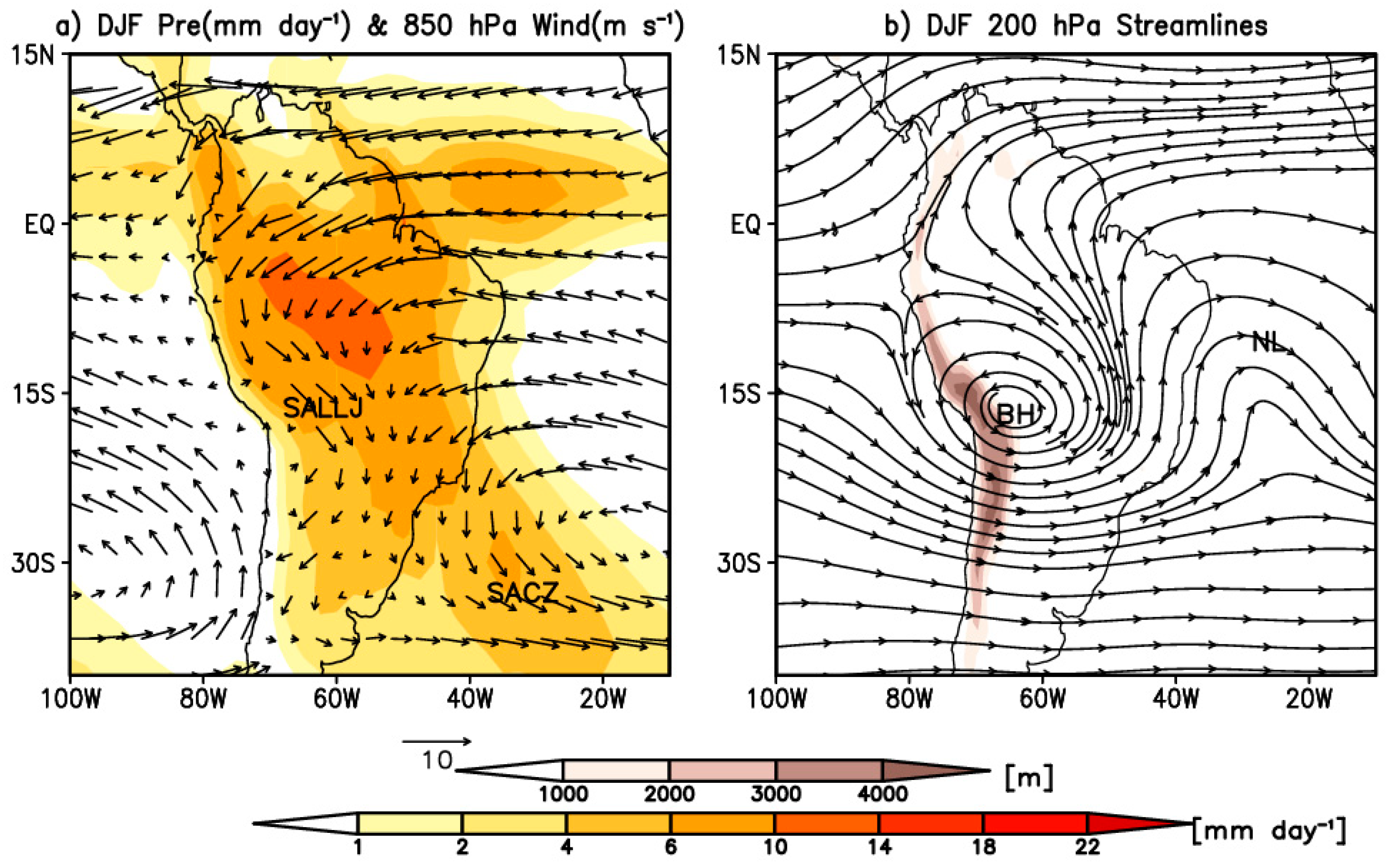
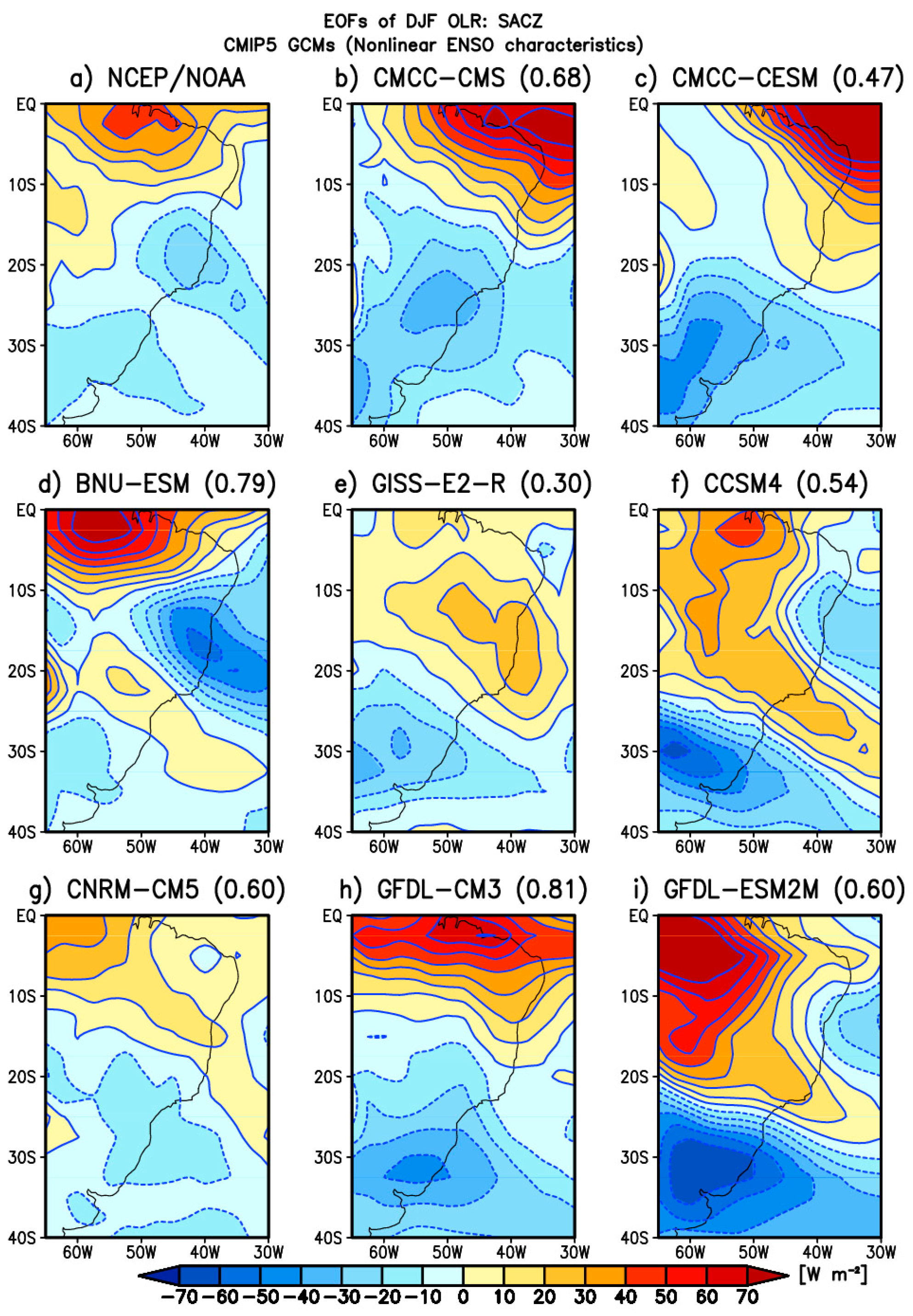
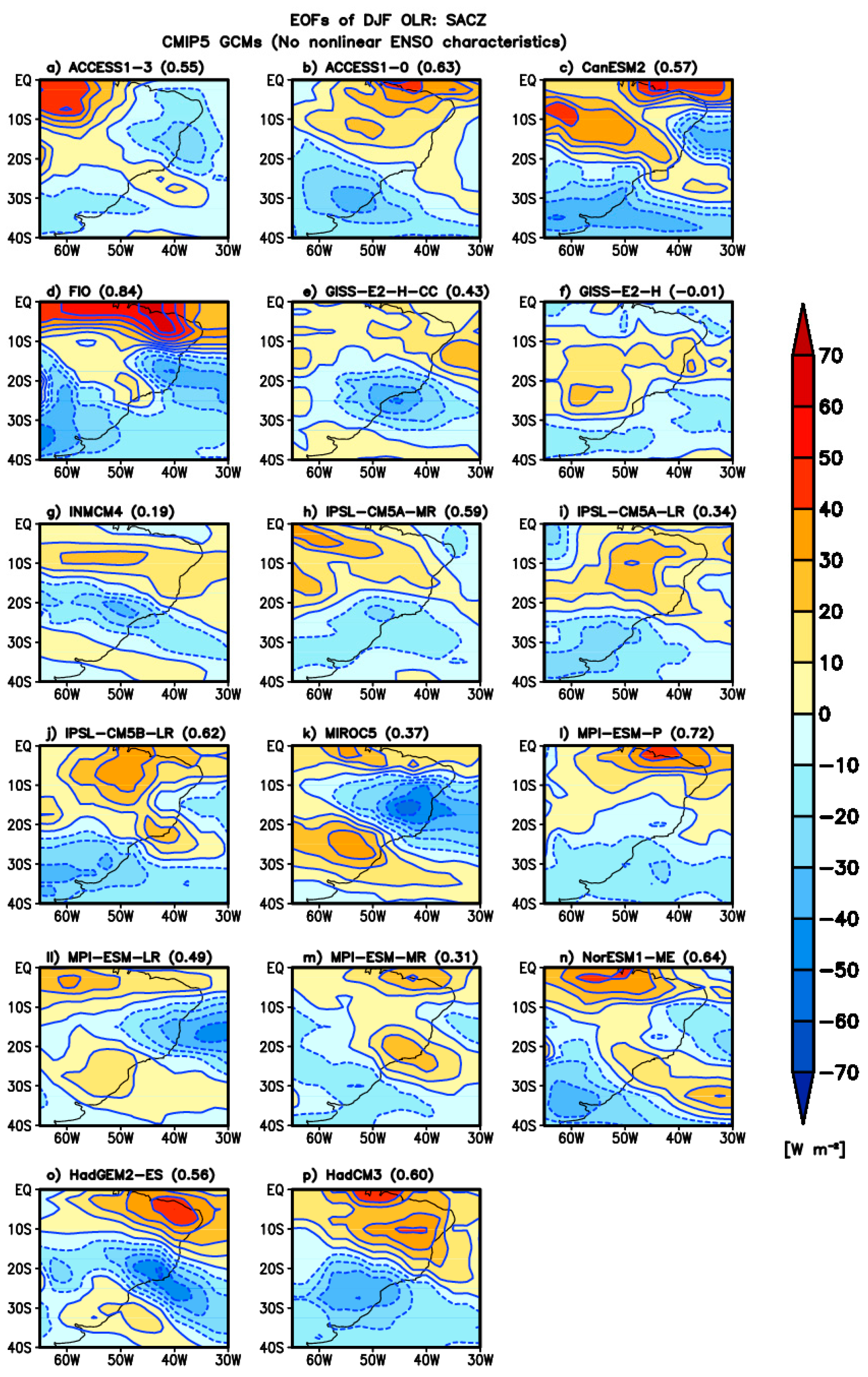
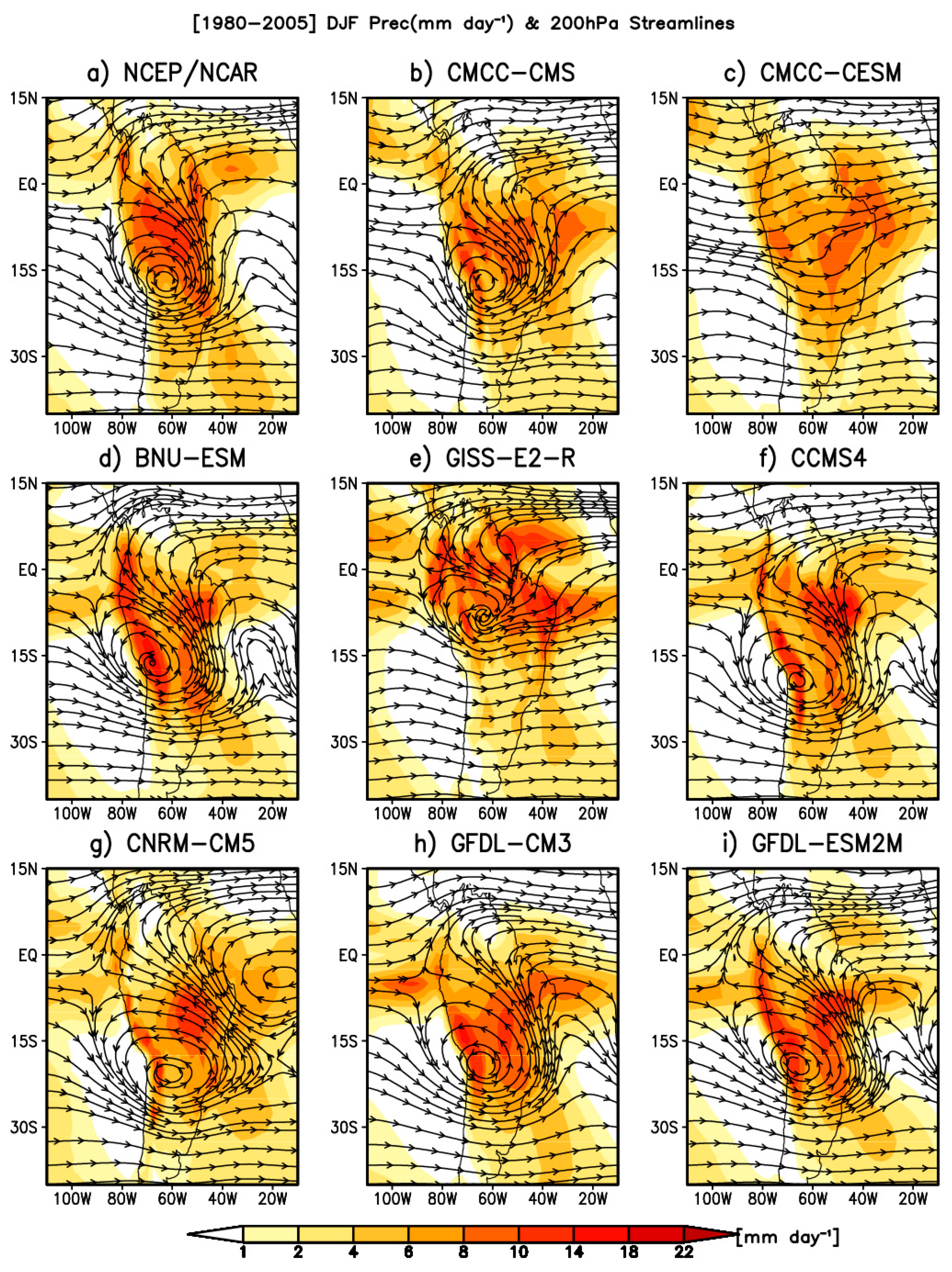
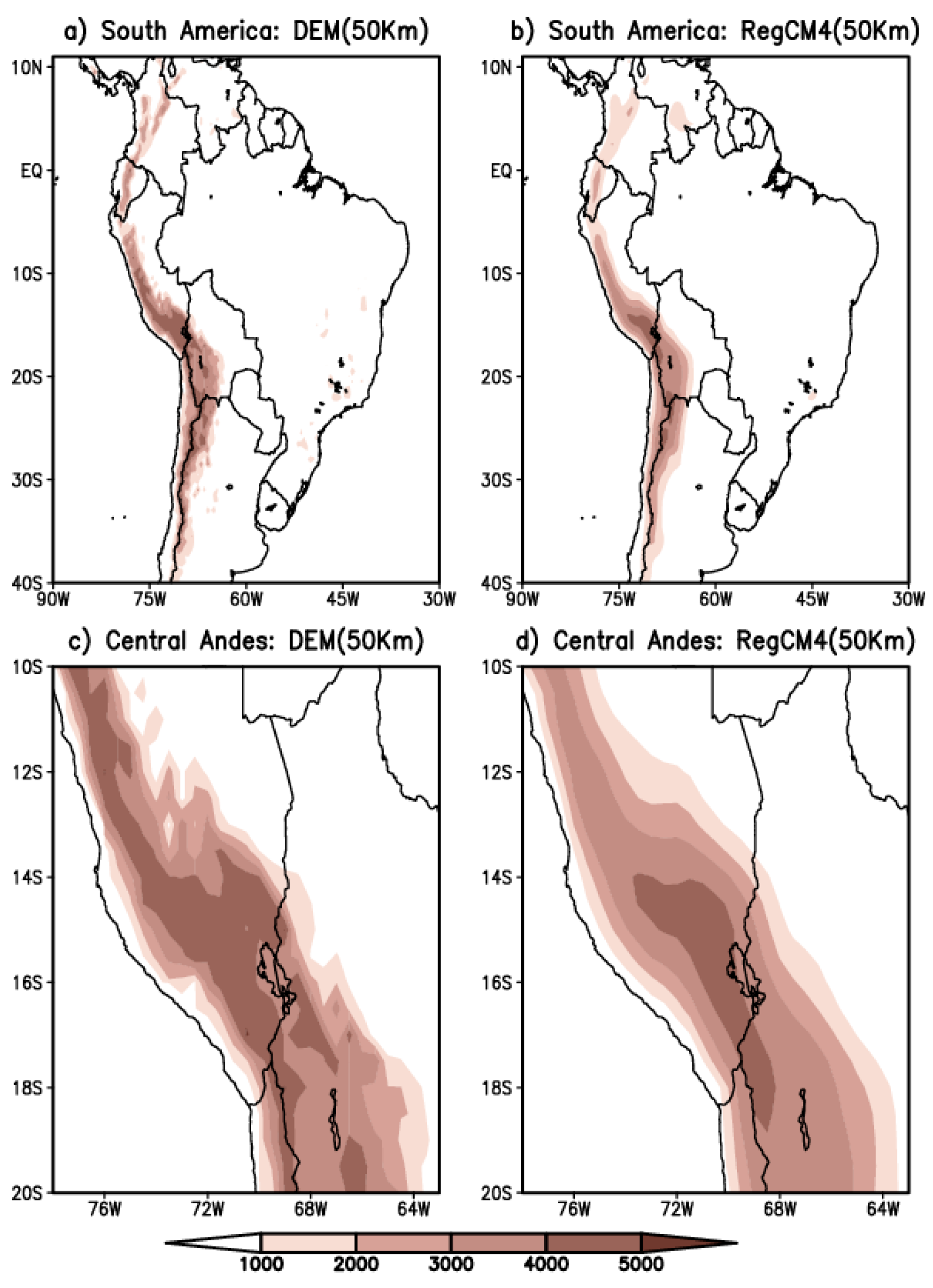
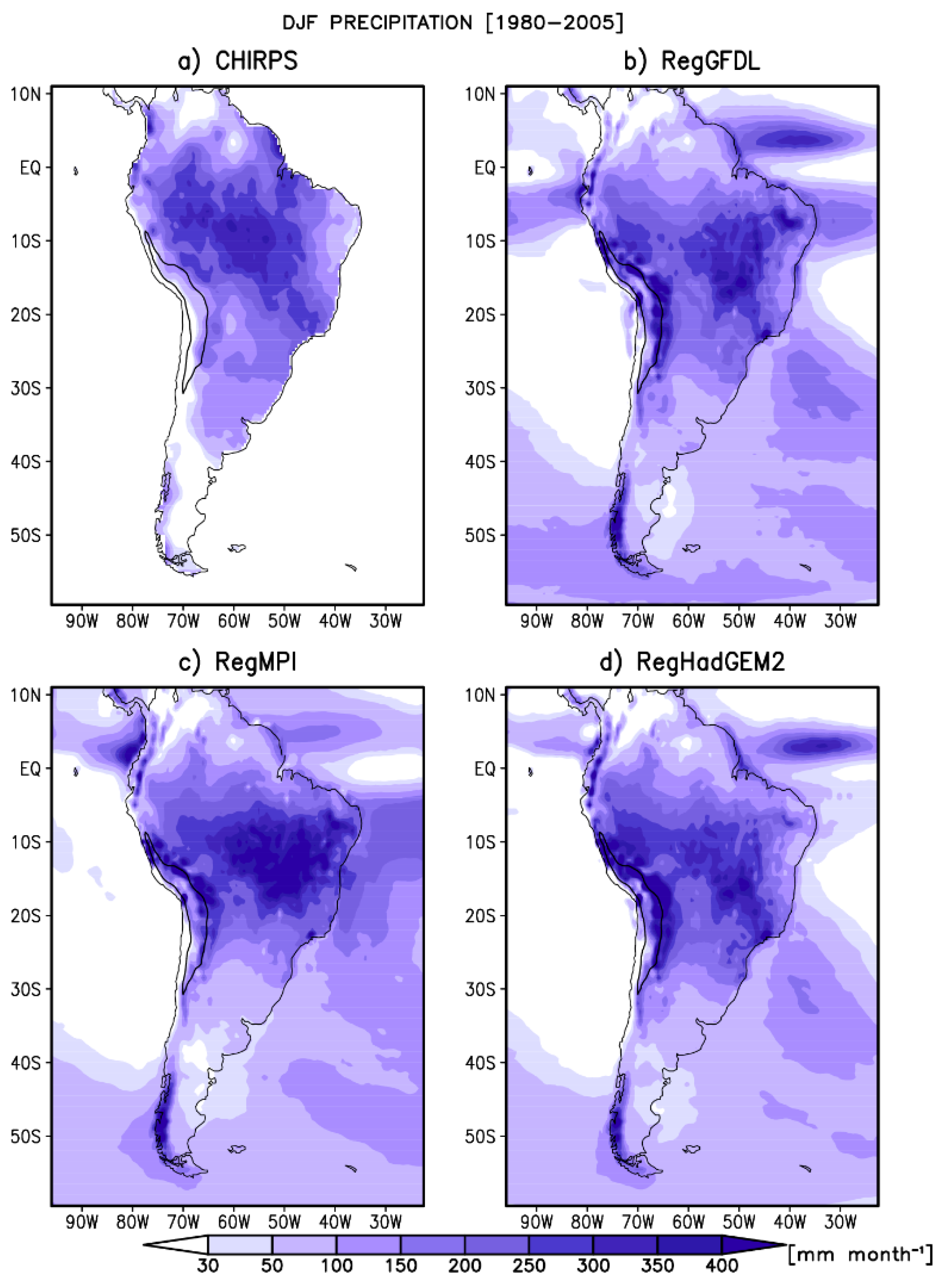
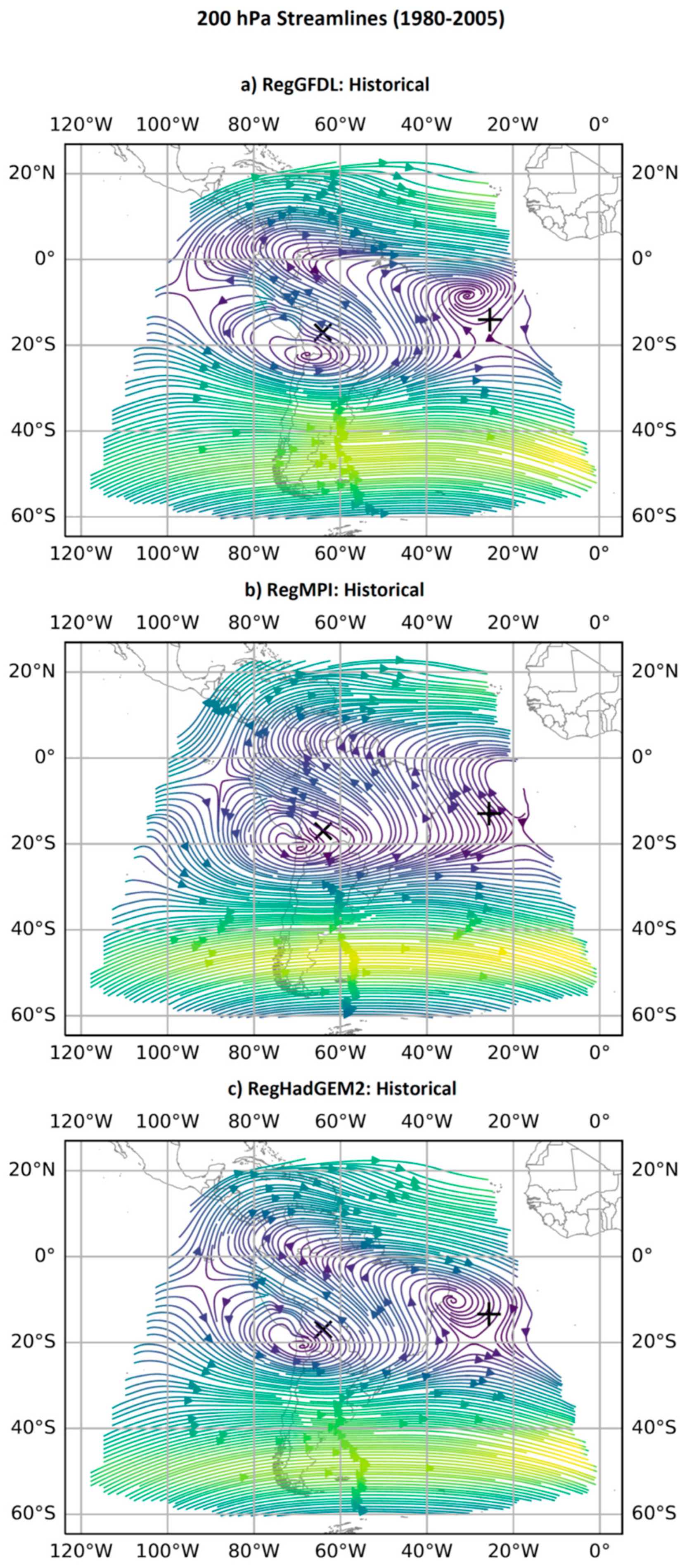
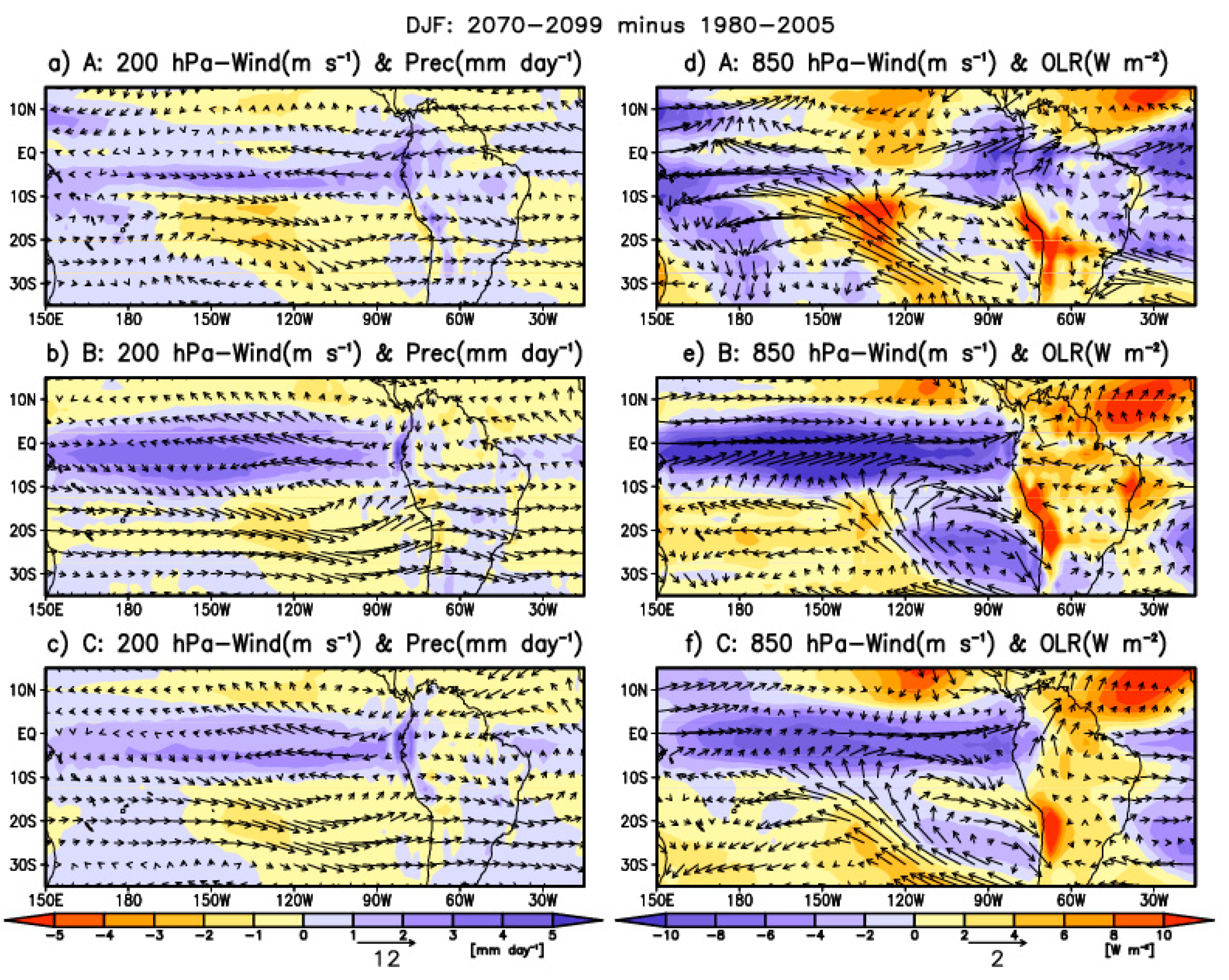
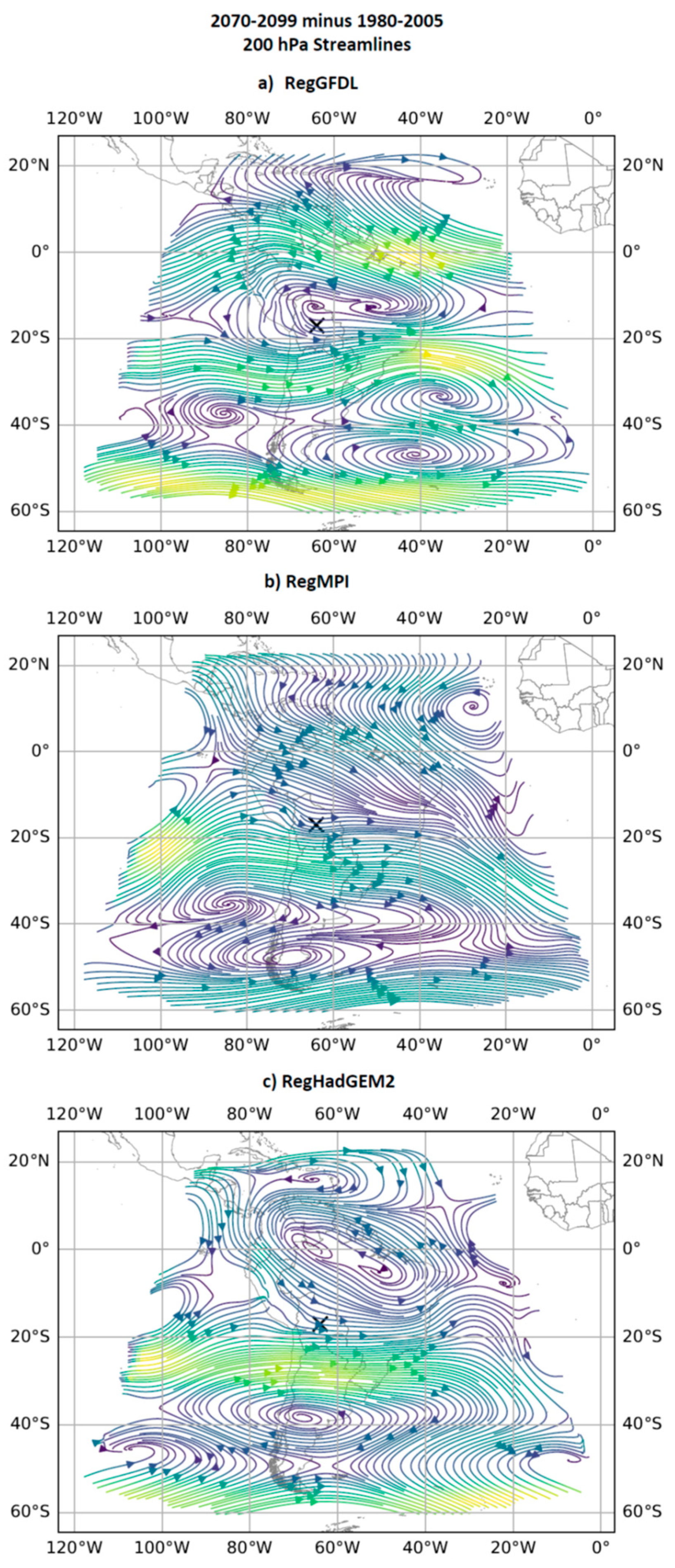
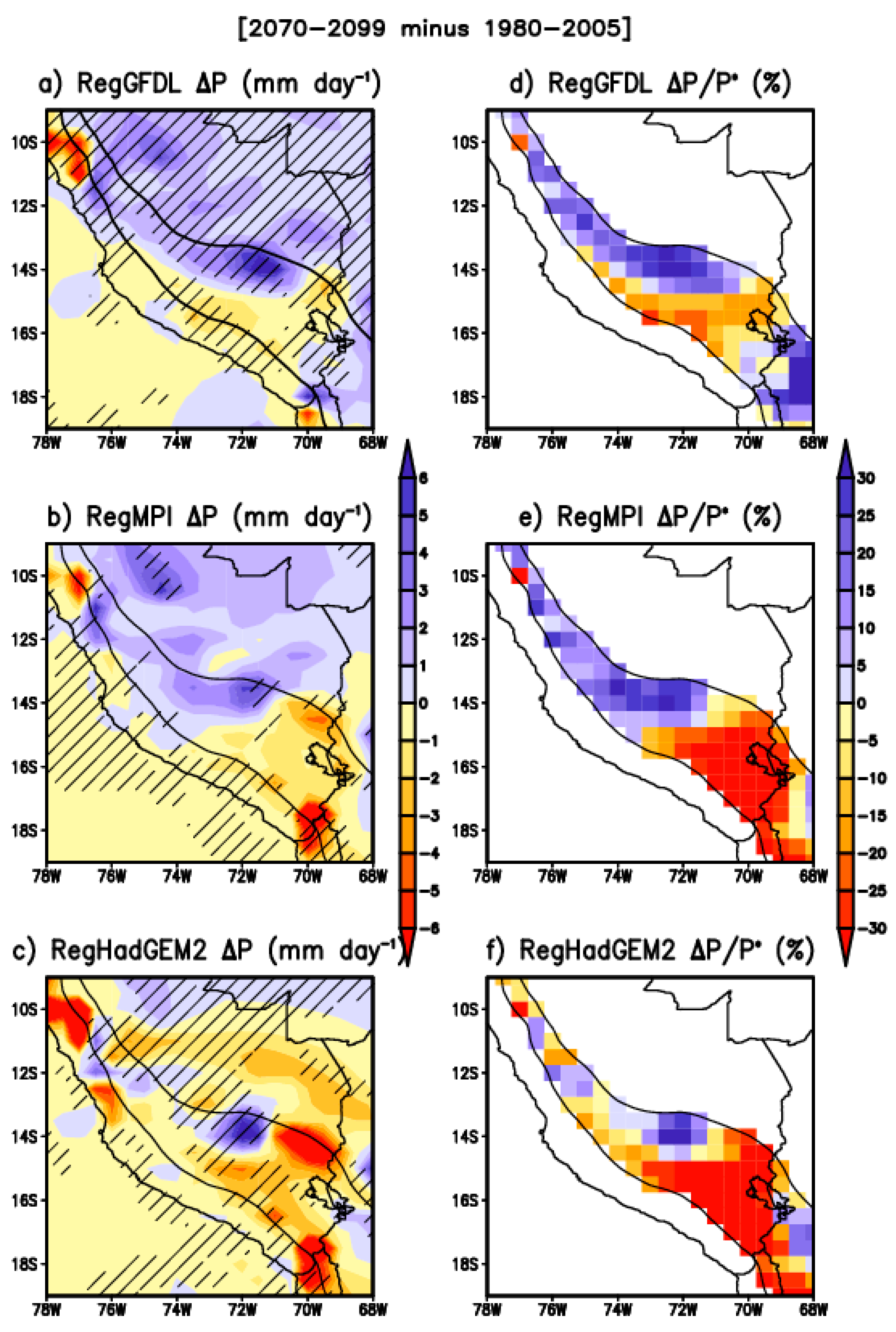
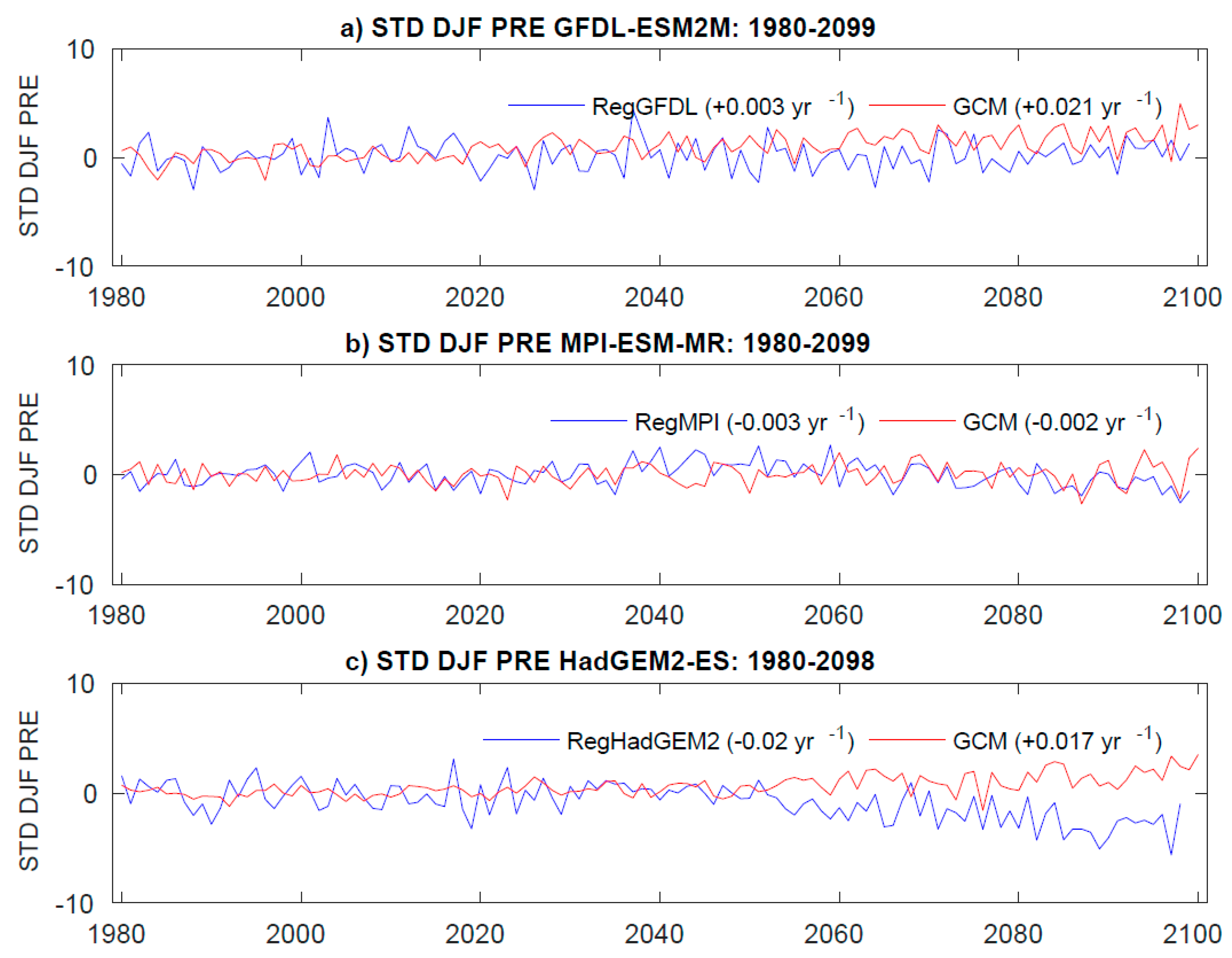
| Modeling Center | Model Name | Atmosphere Resolution (°) | Historical | RCP 8.5 |
|---|---|---|---|---|
| CSIRO and Bureau of Meteorology (BOM), Australia | ACCESS1-0 | 1.875° × 1.25° | X | X |
| ACCESS1-3 | 1.875° × 1.25° | X | X | |
| College of Global Change and Earth System Science, Beijing Normal University | BNU-ESM | 2.8125° × 2.7906° | X | X |
| NOAA/Geophysical Fluid Dynamics Laboratory | GFDL-CM3 | 2.5° × 2° | X | X |
| GFDL-ESM2M | 2.5° × 2.0225° | X | X | |
| NASA Goddard Institute for Space Studies | GISS-E2-R | 2.5° × 2° | X | X |
| GISS-E2-H | 2.5° × 2° | X | X | |
| GISS-E2-R-CC | 2.5° × 2° | X | X | |
| National Center for Atmospheric Research | CCSM4 | 1.25° × 0.9424° | X | X |
| Centre National de Recherches Meteorologiques/Centre Europeen de Recherche et Formation Avancee en Calcul Scientifique | CNRM-CM5 | 1.40625° × 1.4008° | X | X |
| CNRM-CM5-2 | 1.40625° × 1.4008° | X | X | |
| Centro Euro-Mediterraneo per I Cambiamenti Climatici Model CMS | CMCC-CESM | 3.75° × 3.4431° | X | X |
| CMCC-CMS | 3.75° × 3.7111° | X | X | |
| Institute of Atmospheric Physics (IAP) of the Russian Academy of Sciences | INM-CM4.0 | 2° × 1.5° | X | X |
| Institute for Numerical Mathematics L’Institut Pierre-Simon Laplace | IPSL-CM5A-LR | 3.75° × 1.8947° | X | X |
| IPSL-CM5A-MR | 2.5° × 1.2676° | X | X | |
| IPSL-CM5B-LR | 3.75° × 1.8947° | X | X | |
| Environmental Studies, and Japan Agency for Marine-Earth Science and Technology Meteorological Research Institute | MIROC5 | 1.40625° × 1.4008° | X | X |
| Max Planck Institute | MPI-ESM-LR | 1.875 × 1.8653 | X | X |
| MPI-ESM-MR | 1.875 × 1.8653 | X | X | |
| MPI-ESM-P | 1.875 × 1.8653 | X | X | |
| Research Council of Norway | NorESM1-M | 2.5° × 1.8947° | X | X |
| Hadley Centre from the United Kingdom | HadCM3 | 2.5 × 3.75 | X | - |
| HadGEM2-ES | 1.25 × 1.875 | X | X | |
| Beijing Climate Center (BCC), Chinese Meteorological Administration (CMA), China | BCC-CSM1(m) | 2.8125 × 2.7906 | X | X |
| European Community Earth-System Model, Europe | EC-EARTH | 1.125 × 1.1215 | X | X |
| National Science Foundation (NSF)–U.S. Department of Energy (DOE)–NCAR, United States | CESM1-CAM5 | 1.25 × 0.9424 | X | X |
| CMIP5 GCMs | ||
|---|---|---|
| Group A (Nonlinear ENSO Characteristics + SACZ) | Group B (Nonlinear ENSO Characteristics) | Group C |
| BNU-ESM, CCSM4, GFDL-ESM2M | CMCC-CMS, CMCC-CESM, CNRM-CM5, GISS-E2-R, GFDL-CM3 | ACCESS1-0, ACCESS1-3, CanESM2, FIO, GISS-E2-H-CC, GISS-E2-H, INMCM4, IPSL-CM5A-MR, IPSL-CM5A-MR, IPSL-CM5B-LR, MIROC5, MPI-ESM-P, MPI-ESM-LR, MPI-ESM-MR, NorESM1-M, HadCM3, HadGEM2-ES |
Publisher’s Note: MDPI stays neutral with regard to jurisdictional claims in published maps and institutional affiliations. |
© 2021 by the authors. Licensee MDPI, Basel, Switzerland. This article is an open access article distributed under the terms and conditions of the Creative Commons Attribution (CC BY) license (https://creativecommons.org/licenses/by/4.0/).
Share and Cite
Sulca, J.C.; Rocha, R.P.d. Influence of the Coupling South Atlantic Convergence Zone-El Niño-Southern Oscillation (SACZ-ENSO) on the Projected Precipitation Changes over the Central Andes. Climate 2021, 9, 77. https://doi.org/10.3390/cli9050077
Sulca JC, Rocha RPd. Influence of the Coupling South Atlantic Convergence Zone-El Niño-Southern Oscillation (SACZ-ENSO) on the Projected Precipitation Changes over the Central Andes. Climate. 2021; 9(5):77. https://doi.org/10.3390/cli9050077
Chicago/Turabian StyleSulca, Juan C., and Rosmeri P. da Rocha. 2021. "Influence of the Coupling South Atlantic Convergence Zone-El Niño-Southern Oscillation (SACZ-ENSO) on the Projected Precipitation Changes over the Central Andes" Climate 9, no. 5: 77. https://doi.org/10.3390/cli9050077
APA StyleSulca, J. C., & Rocha, R. P. d. (2021). Influence of the Coupling South Atlantic Convergence Zone-El Niño-Southern Oscillation (SACZ-ENSO) on the Projected Precipitation Changes over the Central Andes. Climate, 9(5), 77. https://doi.org/10.3390/cli9050077






